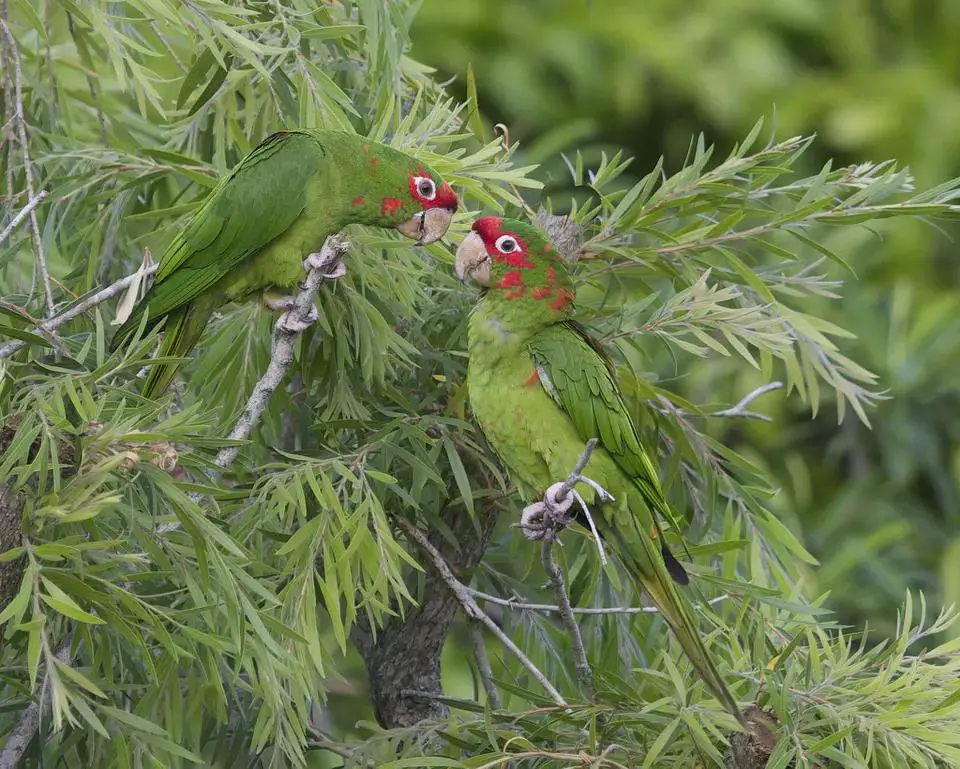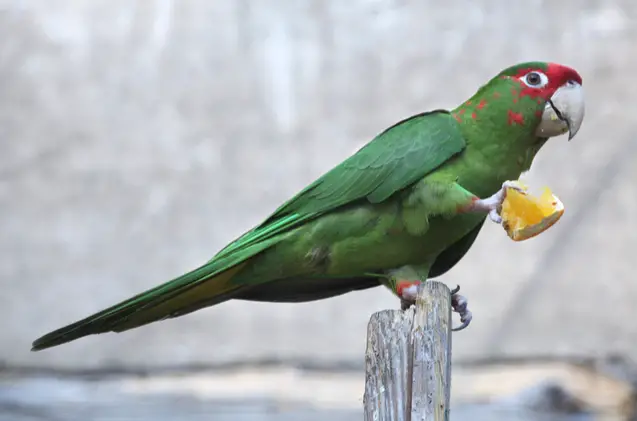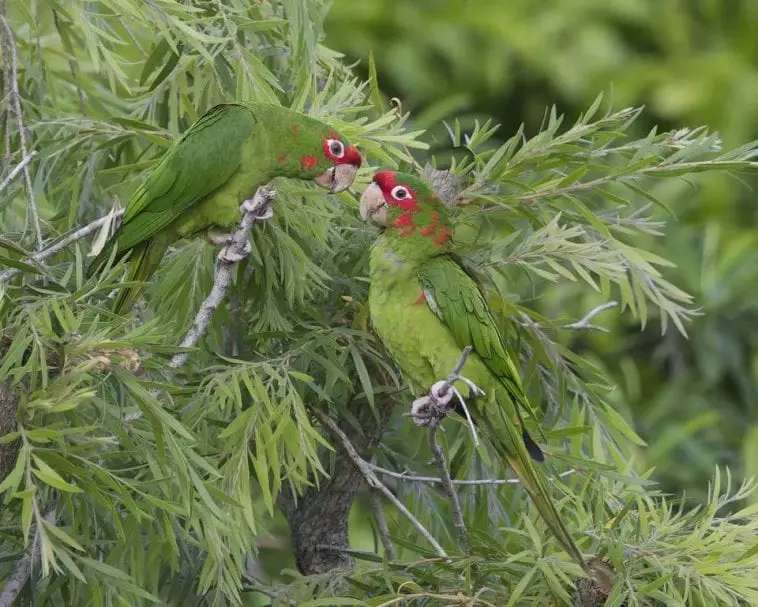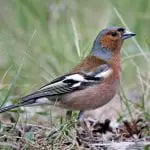Scientific Facts
| Common Name: | Mitred conure, red-headed conure |
| Scientific Name: | Psittacara mitratus |
| Life Span: | 20-30 years (in captivity) |
| Size: | 13-15 inches long |
| Habitat: | Grassy hills, mountainous woodlands, and Andean cloud forests |
| Country of Origin: | South America |
Physical Description

The snappy red and green mitred conure is a cheerful small-to-medium-sized type of parrot that is fond of playing and talking. Since it’s a conure, this bird also comes with an exceptional ability to talk. The mitred conure is a sophisticated-looking bird that has exotic and vibrant plumage that makes the bird stand out regardless of the environment.
The mitred conure has 1 to 2 red feathers on the bend of its wing compared to Cuban, whit-eyed, and red-masked conures. It may have red-colored feathers spread variable on its mantle, hindneck, thighs, and throat.
An immature mitred conure shows minimal to no red feathers. The bird may take up as long as 10 years to have its head in pure red shade. Therefore, the situation differs from one bird to another. There’s a major discrepancy in the number of red-colored feathers a bird may eventually develop.
While its head is red, the rest of the mitred conure’s plumage is green with distinctive red spots on its cheeks and face. Its nearly green plumage plus the bird’s long tail made this bird look noble and sleek. While it is highly similar to its close cousins – the red masked and scarlet fronted conures – still, they are different breeds.
Like the mitred parakeet, the mitred conure is a bigger medium-sized bird that can grow up to 15 inches long. Its long tail adds up to the bird’s overall length.
Its stocky and robust build makes the bird resilient and hardy that is less prone to most health-associated problems. There are no major differences between male and female mitred conures, so a veterinarian who specializes in birds will help you determine its sex.
History and Origin
This conure is native to South American Andean forests from north-central Peru, south across Bolivia to northwest Argentina. In these areas, the mitred conure lives in the forests at the altitude of around 3,000-11,000 feet. Introduced populations can also be spotted in Florida, California, and Hawaii. This bird is occasionally considered a nuisance because of crop damage.
Habitat
The natural habitat of the mitred conure is more common in South America in the deciduous, humid woodlands in the Andes. These forests are typically in high altitudes, covering a large region, including Bolivia, Peru, and Argentina. Some populations have been distributed in Hawaii, Florida, and California.
A mitred conure is a highly sociable bird in the woods. It goes with other birds forming a small flock consisting of 100 birds. Its favorite habitats include the popular grassy hills, Andean cloud forests, and mountainous forests.
Sounds and Speech
While conures are good talking birds, the case is different for the mitred conure. The bird can learn common words or phrases, but its high-pitched voice typically makes the bird sound unintelligible and funny. It does not stop the mitred conure from being talkative. It is a simple, fun, small talking bird that will keep you entertained with its trills and murmurs.
Sometimes, the mitred conure is noisy, but it is a suitable pet for families and individuals. It could become loud if alarmed or in the sunset when its call is designed to assemble the flock.
Personality, Behavior, and Temperament

The mitred conure has been known and appreciated for its playful and outgoing personality. This bird is smart and willing to learn and master new tricks. It can effectively mimic common words. While it is inquisitive and goofy, it could be unpredictable and keen to bite, so take extra caution in petting the bird. However, once you managed to adjust to the bird’s behavior and personality, you will find it a very affectionate friend that will put a smile on your face every day.
A tamed, hand-fed mitred conure can turn into a great pet for families when provided with more attention and love. Like with other pet birds, this species may experience mood swings. The mitred may get nippy. Due to that, this is not a suitable pet bird for families with little kids. Instead, the mitred conure is a perfect option for families with older kids who can already understand and follow directions in handling and taking care of the bird.
In general, the mitred conure is well-socialized and attention-seeker that made it an attractive and fun-loving companion despite its tendency to become loud and noisy. This bird tends to be loud at dusk and dawn periods.
The mitred conure is somewhat ridiculous by nature. Whenever it wants your attention, it will perform tricks just to get you looking at it and laughing.
The mitred conure is a good pet for people who enjoy non-stop interactions with birds. Therefore, it is not a suitable pet for those who are often occupied with more tasks at work or at home. In taking care of a mitred conure, this bird has to be on the top of your list of priorities.
As an enthusiastic and jolly pet bird, the mitred conure enjoys chewing and playing with toys, which the bird does most of the time. Besides, a wild mitred conure stays in a flock. Its natural instinct does not allow the animal itself to be fine with loneliness.
Take note that the bird is prone to mood swings that may happen occasionally. This fun-loving bird may become grumpy and short-tempered sometimes. The bird is fond of doing different tricks inside and even outside the cage. However, if you think your pet will perform better when it’s out of the cage, then the decision is up to you.
For that reason, you should also consider providing your mitred conure with a playpen. That would be a great alternative for the cage whenever you want to take the bird out. Talking with its favorite person will be amusing for others, for sure.
Reproduction and Breeding
The mitred conure is usually a cooperative breeder. One of the possible challenges that you may face in finding the best, acceptable nest box. If it becomes an issue, offering several nest boxes in different sizes and types placed in different locations inside the aviary will let the breeding pair choose their preferred nesting spot.
When the pair chooses a specific nest box, then be sure to keep that exclusively for them. After the pair chooses a nest box, remove the other nest boxes, clean, and reserve them for other purposes.
Feeding
A responsible owner must ensure that the nutritional requisites of his or her pet have been met. In the wild, a mitred conure feasts on nuts, fruits, and seeds. However, it is also okay with a well-balanced pelleted diet together with fresh vegetables, fruits, and nuts.
This conure will demand a variety in its diet. All foods must be rich in nutrients, especially protein. Different diets will work great for this bird. One of these is the pellet-based diet that goes with more sliced veggies and fruits. This will be a very nutritious diet for your pet.
The so-called soak-and-cook is also a good diet for the mitred conure, whether it comes from a commercial dealer or veterinarian. A lot of bird keepers prefer creating a customized grain-and-legume-based diet. This type of diet includes a combination of cooked grains and beans with brown rice.
Preparing a cooked diet in big batches will be a practical option. Keep in the fridge what you will not use for up to 2 days and defrost those items once you need them. Tiny seeds like millet are high in carbohydrates can also be added to the mix and make it healthier. Bigger treat oil seeds such as sunflower could be given by hand. Different nuts can be given by hand or concealed under the bird’s playpen that will encourage the bird to forage. Crack harder nuts if you think the bird will struggle to crack them on its own. Don’t feed your pet with chocolates and avocado.
Note: a mitred conure is susceptible to a condition called conure bleeding syndrome or CBS. The key to prevention is adding those foods rich in vitamin K to your pet’s everyday meals. Examples are dark and leafy greens and turnip greens.
Exercise
Like other species of birds, exercise plays a crucial role in good health and longevity of a mitred conure. This bird in nature is inquisitive and active. You need to provide it with ample space so that it can fly, play, and explore.
Your bird does not have to be kept inside the cage for the rest of its life. You should give it enough time daily to be out of the cage and play while you’re watching over the bird. Your pet must have at least 4 hours to fly every day in a secure and safe place at your home.
Like other parrots, the mitred conure needs to chew, so you should give it some sturdy toys for its chewing habit. It will divert the bird’s gnawing instinct and provide exercise that will be very beneficial to its health.
Common Health Problems of a Mitred Conure
The strong and hardy nature of this bird made it less susceptible to different health problems, allowing the bird to live for 30 years or even longer. It relies on the movement out of the cage in maintaining its good health and overall wellbeing. Hence, plenty of freedom to move and space are both necessary for the health of a mitred conure.
Those things that you’ll need to get to rid of will be cold temperatures, damp, and excessive draft. Poor appetite, apathy, or ruffled feathers are major warning signs.
Like other types of conures, the mitred conure is quite hardy, unlike other parrots. However, this species is vulnerable to other parrots. However, this bird is susceptible to some health problems which are common also to other similar species:
- Sinus inflammation and cold
- Candidiasis
- Feather plucking
- Psittacosis
Aside from that, your pet is also more likely to develop a condition called Pacheco’s disease. If the bird is manifesting common indications like mucus secretions, difficulty to breathe, or loss of appetite, bring it quickly to a licensed veterinarian for proper diagnosis and treatment.
The Mitred Conure as a Pet
This conure is a popular pet among people who enjoy its silly and inquisitive personality. Besides, many appreciate the amazing ability of this bird to learn words and speak. On the other hand, this bird can also become nippy and ill-tempered in some cases, which is quite natural for most conures. It may also become noisy and loud sometimes, which is again a common trait of every conure. These traits are making the mitred conure not a perfect pet for first-time bird keepers.
Availability – Where to Get one?
The mitred conure is a popular pet bird, so this species is typically available at the breeders and pet stores. Whether you choose to buy your pet locally or through the web, you should always check the animal carefully before taking it home. Check the eyes, feathers, feet, beak, and the rest and ensure that the bird is healthy and active.
How to Care for a Mitred Conure?
Both physical and mental aspects need emphasis and consideration to keep a mitred conure healthy and happy. First of all, you should never leave the bird alone. Or else, the bird may disturb everyone in the house and even those in the neighborhood with its high-pitched voice.
The mitred conure is an attention seeker, just like other conures. It wants to be the “star” in your eyes. It wants to be always noticed. Whenever it sees you, it will do everything it can just to get your attention. Therefore, your care and attention are the keys to keeping a mitred conure in a healthy emotional state.
The bird will always crave for that opportunity to play with you. Teach your pet with new words and repeat them to the bird. That will make your pet busy and reduce its tendency to scream for no reason. Playing with the bird should always be one of your daily routines. Interacting with the bird through playing will not only help you build a strong relationship with your pet, but it will also prevent boredom. Bring in some toys and let the fun starts.
After taming and training the bird, be sure it spends a minimum of 2 hours out of the cage to exercise. Remember, a mitred conure is an energetic animal, and it will be using its energy for some activities like flying and wing flapping. You should monitor the bird’s movement, though.
Since bathing is a crucial part and a good thing for a conure, spraying or misting some water on a bird every day at some time. If you’re interested in owning a mitred conure, check out the animal rescue associations and adoption communities. A mitred conure is also a loud bird that the owners find themselves struggling to deal with the racket, so they eventually give up their birds.
Though aviary pet shops might carry a mitred conure, a bird breeder is typically a better alternative. The mitred conure requires a cage of a substantial size. It should have a footprint measuring 24 inches and a height of at least 36 inches. Add some perches and more toys. Also, change them as often as possible to prevent boredom. The mitred conure is athletic, so a playpen will be a good material to use every time you take the bird out of the cage.
A mitred conure loves to bath. Thus, you can mist or spray it with water. You can also put a shallow water dish.
Conures are clever parrots and flock-oriented. They need more mental stimulation that will help in preventing boredom. A bored mitred conure is more likely to experience behavioral problems, and you, as the owner, have to serve as the flock mate of your pet.
A lonely or bored pet might develop biting behavior. The bird may also chew its things inside the cage and even scream a lot. Regular and adequate interaction time between you and the mitred conure will help a lot in preventing it.
This interaction period between you and the animal is best to use for teaching your pet to learn and mimic words or phrases. Remember, the mitred conure is one of the conures with better talking ability. Teaching it to speak will be a good way to enhance the bird’s substantial vocal vigor. If your bird learns more words, then it will be less likely to scream.
Housing
This active bird requires the cage with 2 to 3 perches for the bird’s nail grooming. For aviary issues, if you’re doubtful regarding the perfect nest box, offer your pet a variety of nesting boxes and allow the bird and its mating partner to choose one. That nest box should be exclusive for the pair.
One mitred conure requires a powder-glazed metallic cage with pleasing dimensions. Its measurement should be at least 24 inches wide, 24 inches deep, and 36 inches tall. Use manzanita perches in any region where you do not like to change the perches too often.
Other toys or perches must be rated safe for strong chewers like large conures and Amazon birds. Energetic birds must have a playpen out of the cage that will allow them to explore, investigate the toys or perches, or indulge in hunting for any hidden treats.
Command and train your pet to step up on the perches. This way, you can easily take the bird from the cage going to its play section. This way, you could still enjoy your pet on a neutral territory even when it becomes territorial.
Temperature
For a mitred conure, the ideal temperature ranges from 70 to 80 degrees Fahrenheit. However, a minor change will always be bearable and acceptable. Too low or too high temperatures can be so harmful to your pet and may lead to serious health problems.
Fun Facts about the Mitred Conure
- The scientific name of mitred conure is Psittacara mitratus.
- This bird is native to South America. It lives primarily in deciduous, humid woodlands in the Andes.
- The mitred conure is a bit longer than other conures. It measures 13 to 15 inches long, so it is a small-to-medium-sized bird.
- Taking care of a mitred conure is a long-term commitment. That’s because this bird can live for 20 to 30 years in captivity.
FAQs
What is the scientific name of the mitred conure?
The scientific name of this bird is Psittacara mitratus. It is a talking bird that originated in South America.
How long does the mitred conure grow?
The mitred conure is a small-to-medium-sized bird. Its measurement from head to tail ranges from 13-15 inches.
What is the average lifespan of mitred conure?
The mitred conure has a long lifespan that reaches 20 to 30 years. The bird is sure to live longer when kept in captivity with proper care and nutrition.
Can a mitred conure talk?
The mitred conure has a surprising capability to talk just like other conures. It is good at learning and memorizing common words or phrases.
Does the mitred conure love being handled?
Conures are known for their affectionate and sociable personalities, which is so true for a mitred conure. This bird requires human interaction, so make it a daily habit to talk and play with your pet.
How many hours do I need to spend playing with my mitred conure?
Interactions between you and a mitred conure should take place every day. Give 2 to 4 hours each day in talking, training, playing, and exercising your pet.
What foods should I give to my mitred conure?
You can feed your pet with nuts, fruits, and seeds. Special diets like the pellet-based diet and soak-and-cook will be good for your mitred conure, too.
Is the mitred conure a good pet?
The mitred conure is a fun and loving animal. It loves to do some tricks as it tries to get the attention of everyone.



